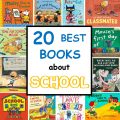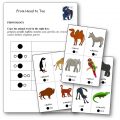Author: Todd Parr
Publisher: Little, Brown Books for Young Readers (2001)
Language: English – Ideal for French-speaking learners (ESL)
Resource Type: Illustrated children’s picture book
Themes: Diversity, Self-acceptance, Emotions, Friendship, Tolerance
Age Range: 4–8 years old (Preschool to Lower Primary)
School Levels: Kindergarten, Grade 1, Grade 2, Grade 3
Summary of the Book
It’s Okay to Be Different is a vibrant and inclusive picture book by Todd Parr that celebrates diversity in all its forms. Through simple and repetitive structures, the book reassures children that it’s perfectly normal to have differences — whether physical, emotional, or familial. From having big ears or no hair, to being adopted or having two moms, this book gently normalizes uniqueness and encourages self-acceptance. The colorful illustrations and humor help deliver a strong message: You are special just because of who you are.
Culture and Vocabulary
- Body & Appearance
tooth, nose, ears, hair, eyes, glasses, color, big, small, extra large - Emotions & Feelings
proud, embarrassed, mad, feelings - Family & Identity
different moms, adopted, invisible friend, different place - Daily Life & Habits
eat in the bathtub, lose your mittens, wear glasses, dance by yourself - Animals & Nature
pet worm, help a squirrel collect nuts
Vocabulary is familiar and concrete, making it highly accessible for young ESL learners.
Grammar and Structures
- Structure “It’s okay to…”
This repeated phrase is central to the book. It models acceptance and empathy and can be reused easily in classroom activities. - Infinitive after “to”
Examples: to be, to have, to come, to dance, to help, to talk - Use of “to be”
All structures are built around “to be”: It’s okay to be small, to be different, to be embarrassed - Modal meaning
“It’s okay to…” acts as a soft modal, offering implicit permission while reassuring the child that what they experience or feel is perfectly normal. - Adjectives and oppositions
different, small, large, proud, embarrassed, invisible
Opportunities to work on opposites (big/small, proud/embarrassed, visible/invisible) - Possessive adjectives
your feelings, yourself, your mittens → implicit use - Diversity of subjects
While the subject “it” is used uniformly, the activities reflect diverse human situations, which can open up discussion and personalization activities.
Phonology
- Repetition and rhythm
The repetition of “It’s okay to…” creates a rhythmic pattern ideal for practicing reading aloud and listening comprehension. - Consonant sounds
- /k/ in okay, collect, color
- /d/ and /t/ in different, tooth, talk, bathtub
- Vowel sounds
- /iː/ in feelings, cheese, medium
- /æ/ in dance, mad, bath
- Word stress practice
Many sentences follow a similar pattern and are useful for practicing English stress timing: “It’s okay to eat macaroni and cheese in the bathtub”
(stressed syllables: okay, eat, macaroni, cheese, bathtub)
Teaching Suggestions
Pre-reading activities
- Show the cover and ask: What do you think this book is about?
- Introduce the key phrase: It’s okay to… and mime examples
During reading
- Pause and ask children to guess the ending: It’s okay to… (have no hair? be different?)
- Point to illustrations and encourage naming body parts, colors, feelings
Post-reading suggestions
- Creative activity: Create a class-made book using the same structure “It’s okay to…” with students’ own drawings (example of student work from a Grade 2 class at Vigenal School in France).
- Personalization: Each student completes the sentence “It’s okay to…” with something personal
- Role-play: Act out different pages (e.g., dancing alone, losing mittens, helping a squirrel)

Phonics
- Highlight repeated sounds or rhymes
- Repeat tricky words chorally for pronunciation support
Grammar focus mini-lesson
- Use a sentence building game with “It’s okay to + verb”
- Mix and match cards: It’s okay to + [verb] + [place or object] → It’s okay to dance + in the kitchen
- Practice questions and answers using adjectives: Are you… (big, tall, small, short, happy, sad, good, bad…)? Yes / No.
How are you? I’m sad, happy…
Cross-Curricular Connections
- Personal, social, health and economic education: respect for differences
- Art: Emotions collage or colorful portraits like in Todd Parr’s style
- Music education: Learn and sing the rhyme “Head, Shoulders, Knees and Toes”
- Body-themed games: Play fun activities to review body parts such as Simon Says, memory game, or a dice game to complete a face
Project Idea: a Bilingual Activity
Use the book to create a bilingual poster: It’s okay to be different / C’est bien d’être différent
Conclusion
It’s Okay to Be Different is more than just a story — it’s a tool for developing both English skills and emotional intelligence. Through its simplicity, repetition, and strong message of self-worth, it offers a rich pedagogical resource for French-speaking learners of English. Perfect for working on vocabulary, rhythm, inclusion, and confidence in the classroom.





